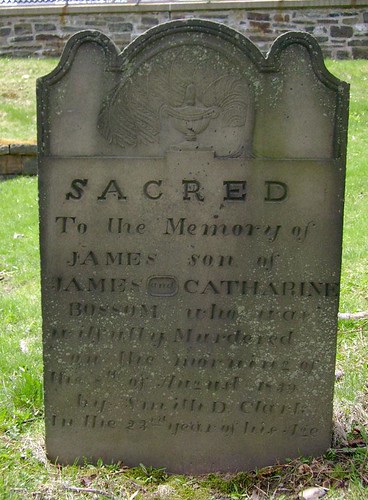Since its founding, Halifax has had its share of bars and brothels that catered to soldiers and sailors on a spree. In olden times, many of the dives were clustered in the area around Citadel Hill, close to the military barracks. Barrack Street was home to the city’s most unsavoury characters, none more unsavoury than young James Bossom.
James Bossom senior ran one of Barrack Street's most notorious taverns,and the apple didn't fall far from the tree. James junior was a bully and street tough, so thoroughly disliked that when he was murdered, some people demanded that his killer, Smith D. Clark, go free because he'd done the city a service, while James' cronies rioted, insisting Clark be hung. Apparently he was sentenced to death, but was pardoned by Queen Victoria on the occasion of her marriage, because of the extenuating circumstances (Bossom had taunted and threatened him repeatedly.)James was buried in the Old Burying Ground - with his murderer’s name on his headstone.

When I saw this stone a few years ago, I just had to find the story behind it. Here it is, briefly told by a local historian. If you'd like a complete version, click here.
Another suitable story for the season is that of the Five Fishermen Restaurant and Grill, a downtown restaurant that specializes in fine seafood – with a side of the supernatural. You see, the two-hundred year-old building that houses the Five Fishermen was once a funeral home. The bodies of Titanic victims were taken there, as were those of Explosion victims. Diners and staff have experienced mysteriously mobile cutlery, disembodied voices and shadowy apparitions. Good for the appetite? I guess that’s a matter of opinion.
The fort on Citadel Hill is also said to be haunted. Visitors to the historic site have reported strange occurrences – such as sightings of uniformed men who are believed to be costumed staff until they vanish through walls. Ghostly voices have been heard there as well.
Then there’s Canada’s oldest church, St. Paul's Anglican, just across from City Hall. From a sidewalk on the right side of the church, the shadowy silhouette of a man's face can easily be seen in an upper-level rounded window. The face supposedly belonged to a one-time assistant at Saint Paul’s, who died in the Explosion. Though the window has been replaced, the silhouette remains.
It was a ghost story that inspired me to write Shattered. A friend of mine who lives in the North End told me she came home from work one day, looked in her kitchen window and saw a man in old-fashioned clothes, sitting at her table. As she told the tale I pictured her visitor – blond, stocky, with hazel eyes and a tough-looking face. The kind of man who’d fight someone in an alley for the heck of it, then drink with him afterward. Like Liam Cochrane.
People of Blogland, do you have any good ghost stories to share?





